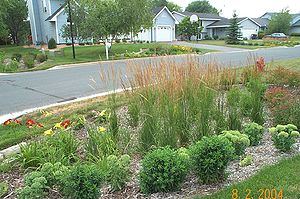
Difference between revisions of "Infiltration design guideline - landscaping"
m |
m |
||
| (One intermediate revision by the same user not shown) | |||
| Line 5: | Line 5: | ||
Landscaping is critical to the performance and function of vegetated areas of infiltration practices. Therefore, a landscaping plan is ''HIGHLY RECOMMENDED'' for vegetated infiltration practices. ''RECOMMENDED'' planting guidelines for vegetated practices are as follows. | Landscaping is critical to the performance and function of vegetated areas of infiltration practices. Therefore, a landscaping plan is ''HIGHLY RECOMMENDED'' for vegetated infiltration practices. ''RECOMMENDED'' planting guidelines for vegetated practices are as follows. | ||
| − | *Vegetation should be selected based on a specified zone of <span title="An environment or habitat containing plenty of moisture; very wet"> '''hydric'''</span> tolerance. [ | + | *Vegetation should be selected based on a specified zone of <span title="An environment or habitat containing plenty of moisture; very wet"> '''hydric'''</span> tolerance. [https://stormwater.pca.state.mn.us/index.php?title=Minnesota_plant_lists ''Plants for Stormwater Design - Species selection for the Upper Midwest''] is a good resource. |
*Native [[Minnesota plant lists|plant species]] should be specified over non-native species. Hardy <span title="A species that has been observed in the form of a naturally occurring and self-sustaining population in historical times. Non-natives do not meet this definition."> '''native species'''</span> that thrive in our ecosystem without chemical fertilizers and pesticides are the best choices. | *Native [[Minnesota plant lists|plant species]] should be specified over non-native species. Hardy <span title="A species that has been observed in the form of a naturally occurring and self-sustaining population in historical times. Non-natives do not meet this definition."> '''native species'''</span> that thrive in our ecosystem without chemical fertilizers and pesticides are the best choices. | ||
*Many vegetated practices feature wild flowers and grasses as well as shrubs and some trees. | *Many vegetated practices feature wild flowers and grasses as well as shrubs and some trees. | ||
| Line 21: | Line 21: | ||
Operation and maintenance of vegetated practices is critical to meeting these landscape recommendations and targets. For more information on operation and maintenance, see the section on [[Operation and maintenance of bioretention#Recommended maintenance activities for bioretention areas|operation and maintenance of stormwater infiltration practices.]] | Operation and maintenance of vegetated practices is critical to meeting these landscape recommendations and targets. For more information on operation and maintenance, see the section on [[Operation and maintenance of bioretention#Recommended maintenance activities for bioretention areas|operation and maintenance of stormwater infiltration practices.]] | ||
| + | |||
| + | [[Category:Level 3 - Best management practices/Structural practices/Infiltration (trench/basin)]] | ||
| + | [[Category:Level 3 - Best management practices/Specifications and details/Design criteria]] | ||
Latest revision as of 19:20, 27 December 2022
Warning: It is REQUIRED that impervious area construction is completed and pervious areas established with dense and healthy vegetation prior to introduction of stormwater into a vegetated infiltration practice.
Landscaping is critical to the performance and function of vegetated areas of infiltration practices. Therefore, a landscaping plan is HIGHLY RECOMMENDED for vegetated infiltration practices. RECOMMENDED planting guidelines for vegetated practices are as follows.
- Vegetation should be selected based on a specified zone of hydric tolerance. Plants for Stormwater Design - Species selection for the Upper Midwest is a good resource.
- Native plant species should be specified over non-native species. Hardy native species that thrive in our ecosystem without chemical fertilizers and pesticides are the best choices.
- Many vegetated practices feature wild flowers and grasses as well as shrubs and some trees.
- If woody vegetation is placed near inflow locations, it should be kept out of pretreatment devices and be far enough away to not hamper maintenance of pretreatment devices.
- Trees should not be planted directly overtop of underdrain and may be best located along the perimeter of the practice.
- Salt resistant vegetation should be used in locations with probable adjacent salt application, e.g. roadside, parking lot, etc.
- Plugs, bare root plants or potted plants are RECOMMENDED over seed for herbaceous plants, shrubs, and trees. Erosion control mats pre-vegetated with herbaceous perennial plants are also acceptable. For turf, sod is recommended over seed. (NOTE: Fluctuating water levels following seeding (prior to germination) can cause seed to float and be transported, resulting in bare areas that are more prone to erosion and weed invasion than vegetated areas. Seed is also difficult to establish through mulch, a common surface component of vegetated practices. It may take more than two growing seasons to establish the function and desired aesthetic of mature vegetation via seeding.)
- Vegetated practices should be operated offline for 1 year or, within the first year, until vegetation is established.
- Example target plant coverage includes
- at least 50 percent of specified vegetation cover at end of the first growing season;
- at least 90 percent of specified vegetation cover at end of the third growing season;
- supplement plantings to meet project specifications if cover targets are not met; and
- tailoring percent coverage targets to project goals and vegetation. For example, percent cover required for turf after 1 growing season would likely be 100 percent, whereas it would likely be lower for other vegetation types.
- Vegetated areas should be integrated into the site planning process, and aesthetic considerations should be taken into account in their siting and design.
Operation and maintenance of vegetated practices is critical to meeting these landscape recommendations and targets. For more information on operation and maintenance, see the section on operation and maintenance of stormwater infiltration practices.
This page was last edited on 27 December 2022, at 19:20.
